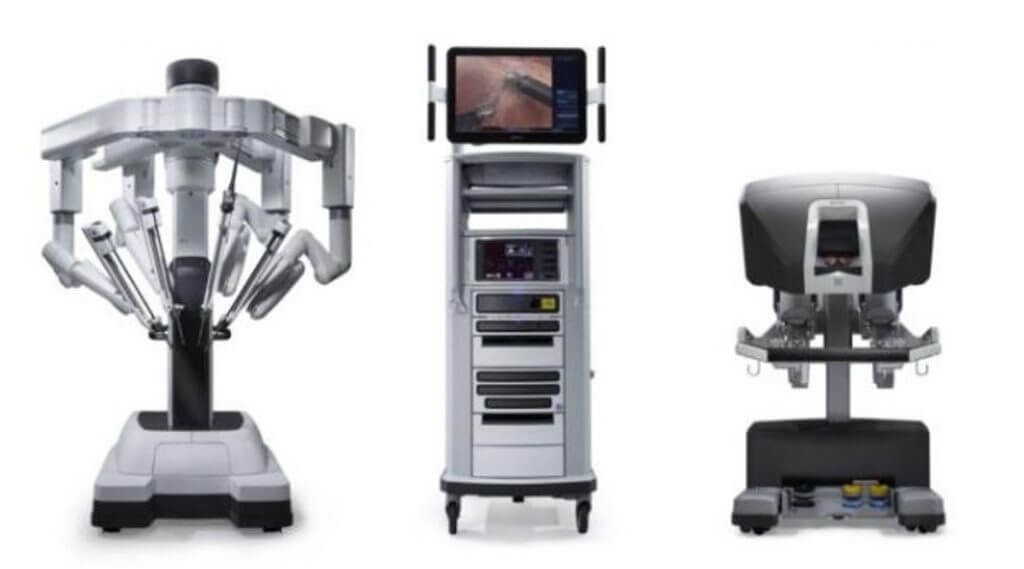Robotics and Uro-Oncology Surgery
Home Robotics and Uro-Oncology Surgery

Urologic oncology is the field of medicine concerned with the research and treatment of cancers of the urinary system for both genders, as well as those affecting the male sexual organs. Dr Rahul Yadav is one of the best Robotic uro-oncology surgeons with a successful career of more than a decade. Robotic uro-oncology is a type of keyhole (laparoscopic) surgery. It is also called Da Vinci Robotic Surgery. A surgeon does the surgery with a special machine (robot) to help.
What Is Robotic Surgery?
A surgical robot is a self-powered, computer-controlled device that can be programmed to aid in the positioning and manipulation of surgical instruments, enabling the surgeon to carry out more complex tasks. Systems currently in use are not intended to act independently from human surgeons or to replace them.
How Does The Robotic Surgical System Work?
To operate using the Robotic system, the surgeon makes tiny incisions in the patient’s body and inserts miniaturized instruments and a high-definition three-dimensional camera. Sometimes skin incisions are not required at all. Then, from a nearby console, the surgeon manipulates those instruments to perform the operation. During a Robotic- assisted procedure, the surgeon uses master controls to manipulate the instruments, and the instruments translate your surgeon’s movements into precise movements inside the patient’s body. The surgeon is in control the whole time; the surgical system responds to the direction he provides.
When Is Robotics In Uro-Oncology Used?
Robotics is used for surgeries like Robotic Assisted Partial/Radical Nephrectomy/Nephro-ureterectomy, Robotic Assisted Adrenalectomy, Robotic Assisted Radical Cystoprostatectomy with Intracorporeal Ileal Conduit/Neobladder, Robotic Assisted Radical Prostatectomy, Robotic Assisted Retro-Peritoneal Lymph Node Dissection, Robotic kidney removal, Robotic prostate removal, Robotic bladder removal, Robotic heminephrectomy/Nephrectomy/Partial Nephrectomy, Robot Assisted Ureteral reimplantation/reconstruction.
Robotic Surgery Is Also A Specialized Type Of Minimally Invasive Surgery And How Is Robotic Surgery Performed?
General anesthesia is given during the procedure. The doctor makes several small keyhole incisions in your abdomen. Then the doctor will pass carbon dioxide gas through the area to easily view internal structures. After that doctor passes a small camera (endoscope) through one of the incisions. The camera lights, magnifies and projects the structures onto a video screen. The camera is attached to one of the robotic arms. The other arms hold instruments for grasping, cutting, dissecting and suturing.The procedure takes between 2-4 hours. Thanks to the technical benefits of the robotic system, utilization of minimally invasive techniques has increased over the last decade. The robotic approach has become the standard approach in performing radical prostatectomy and partial nephrectomy for small renal tumors. Even technically challenging procedures such as radical cystectomy and intracorporeal urinary diversion have been standardized in experienced centers.
What Are The Benefits Of Robotic-Assisted Surgery?
There are many benefits to having a Robotic-assisted surgery. A Robotic-assisted surgery benefits you directly—shorter recovery time—as well as indirectly—the surgeon has better visualization, leading to a more precise surgery. Other benefits:
✓ Your surgeon has greater range of motion and dexterity
✓ Your surgeon sees a highly-magnified, high-resolution image of the operating field
✓ Your surgeon has better access to the area being operated on
✓ Shorter hospital stay
✓ Less risk of infection
✓ Less blood loss and fewer blood transfusions
✓ Less pain
✓ Faster recovery
✓ Quicker return to daily routine
The Next Frontier In Robotics
In complex reconstruction cases, identification of key anatomic structures remains paramount for a successful outcome. For example, identification of the ureter can be very difficult in re-do surgery or in cases of retroperitoneal fibrosis. Re-do ureteral procedures such as pyeloplasty, recurrent stricture, reimplantation including Boari flap, uretero-enteric strictures, and ureteral reimplantation of transplanted kidneys are facilitated by technology offered by robotics.
What Procedures Can Be Done From Robotic Surgery In Urology?
The following procedures can be done in urology via robotic system:
✓ Radical prostatectomy
✓ Partial nephrectomy
✓ Radical nephrectomy
✓ Radical nephroureterectomy
✓ Reconstructive renal & ureteral surgeries- ureteric reimplantation etc.
✓ Pyeloplasty for uretero-pelvic junction obstruction (UPJO)
✓ Adrenalectomy
✓ Cystectomy
✓ Urinary diversion
✓ Retroperitoneal and inguinal lymph nodes dissection
✓ Kidney transplantation
Although still in its infancy, robotic surgery is a cutting-edge development in surgery that will have far-reaching implications. While improving precision and dexterity, this emerging technology allows surgeons to perform operations that were traditionally not amenable to minimal access techniques. As a result, the benefits of minimal access surgery may be applicable to a wider range of procedures. Safety has been well established, and many series of cases have reported favorable outcomes. However, randomized, controlled trials comparing robotic-assisted procedures with laparoscopic or open techniques are generally lacking.
Robots and surgeons will continue to evolve. In referral centers, we will likely see more and more difficult procedures performed robotically as experience continues to grow. In addition to the now standardized oncologic surgeries, we will see more complex reconstructions and vascular surgeries (including IVC thrombectomy and kidney transplantation) performed with a robot.
The future of robotics in urology remains bright, with new platforms and technology on the near horizon. The robot battle is set to begin.